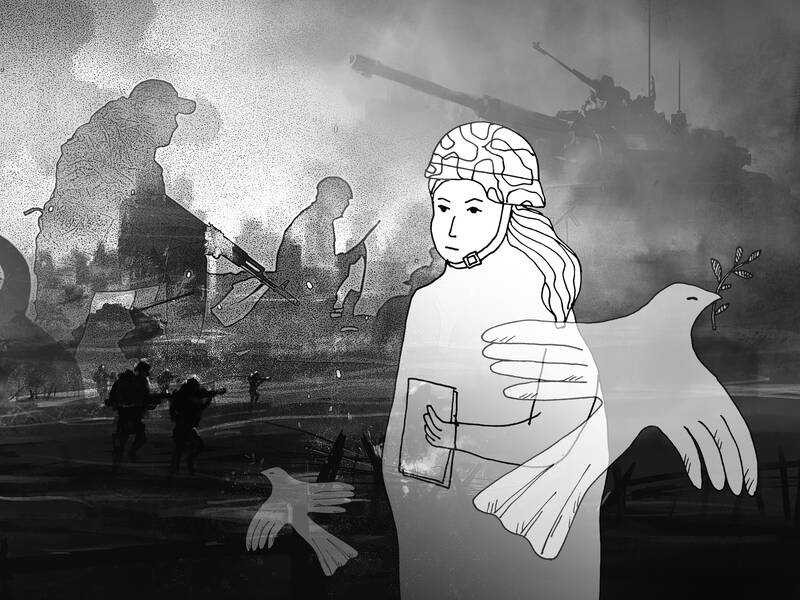Despite all the progress that has been made toward gender equality globally, many are still tempted to view armed conflict as primarily the domain of men. In fact, women often prove decisive in such settings, including in combat, noncombat and leadership roles. Nonetheless, they are routinely sidelined in formal peace processes and post-conflict governance. This pattern reflects a moral and practical failure.
During armed conflicts, women become more vulnerable to genocide, trafficking, slavery and sexual violence, with all the associated health risks and psychological trauma. This alone earns them the right to participate in peace processes. However, women are not only passive victims of conflict: As we have seen in Ukraine, they make profound wartime contributions on the battlefield, as well as in civil society and as peace advocates.
In this sense, women often increase their agency during times of conflict, despite the risks they face, but when they are then excluded from peace negotiations and what follows — as is the case, so far, in Ukraine — these agency gains are reversed, with outdated gender norms reasserting themselves. This is especially true in conflict-affected countries with more entrenched patriarchal structures.

Illustration: Tania Chou
Legal frameworks promoting women’s inclusion in conflict resolution, peace-building and post-conflict reconstruction have so far failed to turn the tide, owing partly to implementation and operational challenges. For example, UN Security Council Resolution 1325, adopted in 2000, “urges all actors” to increase women’s participation and “incorporate gender perspectives in all UN peace and security efforts.” However, as of 2018, the number of women signing peace agreements had not significantly increased.
This has important implications for the content — and outcomes — of peace agreements. In a recent study, my coauthors — Matthew Clance, Romuald Meango and Charl van Schoor — and I used natural language processing to examine the use of gendered language (including words like man, girl, boy, her, his, female, male, wife and daughter) in peace agreements reached between 1990 and 2023. We created a “gender bias index” — ranging from minus-0.6 to 0.6 — with a lower score indicating lower use of gendered language and, thus, a reduced focus on gender-based outcomes.
None of the peace agreements we studied had a particularly high gender bias index, but even those that used more gendered language — which reflected a somewhat positive bias toward women — were not necessarily associated with significant improvements in women’s agency. In other words, even frameworks that were gender-sensitive (acknowledging gender inequality) did not bring about meaningful change.
The problem is that the mentions of gender were not accompanied by concrete requirements, let alone monitoring and enforcement mechanisms. For example, a peace agreement might advocate for increased women’s political participation, but include no targets to be met, and thus produce few, if any, results. This approach can even harm gender equality, by giving the impression that action is being taken when it is not.
Other studies show that peace agreements with disarmament, demobilization and reintegration (DDR) components rarely mention women. This compromises the post-conflict rehabilitation of female combatants, who might be excluded from the kinds of interventions aimed at their male counterparts.
Evidence shows that including women in conflict-resolution and peace-building processes leads to better outcomes for everyone. As a 2018 analysis found, there is a “robust correlation” between the inclusion of female delegates as signatories of peace agreements and the durability of the ensuing peace. Moreover, agreements signed by women tend to include significantly more provisions focused on political reform and boast higher implementation rates for such provisions.
In El Salvador, the 1992 agreement that ended the country’s 12-year civil war extended DDR benefits to female fighters, and included noncombatant female members of the opposition movement in reintegration programs. Women went on to play a stabilizing role in reintegration processes and to make major contributions to reconstruction efforts. The communities that received more consistent, systematic support through reintegration and reconstruction programs made greater progress on gender equality and, ultimately, on development.
Similarly, in Liberia, women were involved in negotiations to end more than a decade of civil war in the early 2000s. Female representation in politics subsequently increased significantly, with Ellen Johnson Sirleaf in 2005 becoming the first female elected head of state in Africa.
The message is clear: Women must be included in all dimensions of any peace process, from designing, negotiating, and signing agreements to implementing post-conflict stabilization and reconstruction plans. They also must have access to all relevant benefit programs, such as those related to DDR, as well as initiatives to address gender-specific needs.
More broadly, peace processes must clearly recognize and directly promote women’s agency. This does not mean paying lip service to women’s needs and contributions, while relying on ambiguous language to minimize accountability. Rather, supporting women’s agency in making peace and forging the post-conflict future demands concrete, enforceable measures to uphold women’s rights and expand their participation in all forms of decision-making.
Carolyn Chisadza is associate professor of economics at the University of Pretoria.
Copyright: Project Syndicate

“History does not repeat itself, but it rhymes” (attributed to Mark Twain). The USSR was the international bully during the Cold War as it sought to make the world safe for Soviet-style Communism. China is now the global bully as it applies economic power and invests in Mao’s (毛澤東) magic weapons (the People’s Liberation Army [PLA], the United Front Work Department, and the Chinese Communist Party [CCP]) to achieve world domination. Freedom-loving countries must respond to the People’s Republic of China (PRC), especially in the Indo-Pacific (IP), as resolutely as they did against the USSR. In 1954, the US and its allies
A response to my article (“Invite ‘will-bes,’ not has-beens,” Aug. 12, page 8) mischaracterizes my arguments, as well as a speech by former British prime minister Boris Johnson at the Ketagalan Forum in Taipei early last month. Tseng Yueh-ying (曾月英) in the response (“A misreading of Johnson’s speech,” Aug. 24, page 8) does not dispute that Johnson referred repeatedly to Taiwan as “a segment of the Chinese population,” but asserts that the phrase challenged Beijing by questioning whether parts of “the Chinese population” could be “differently Chinese.” This is essentially a confirmation of Beijing’s “one country, two systems” formulation, which says that
Indian Prime Minister Narendra Modi arrived in China yesterday, where he is to attend a summit of the Shanghai Cooperation Organization (SCO) with Chinese President Xi Jinping (習近平) and Russian President Vladimir Putin today. As this coincides with the 50 percent US tariff levied on Indian products, some Western news media have suggested that Modi is moving away from the US, and into the arms of China and Russia. Taiwan-Asia Exchange Foundation fellow Sana Hashmi in a Taipei Times article published yesterday titled “Myths around Modi’s China visit” said that those analyses have misrepresented India’s strategic calculations, and attempted to view
When Chinese President Xi Jinping (習近平) stood in front of the Potala Palace in Lhasa on Thursday last week, flanked by Chinese flags, synchronized schoolchildren and armed Chinese People’s Liberation Army (PLA) troops, he was not just celebrating the 60th anniversary of the establishment of the “Tibet Autonomous Region,” he was making a calculated declaration: Tibet is China. It always has been. Case closed. Except it has not. The case remains wide open — not just in the hearts of Tibetans, but in history records. For decades, Beijing has insisted that Tibet has “always been part of China.” It is a phrase